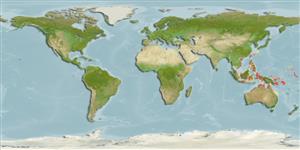Pycnogonida |
Pantopoda |
Ammotheidae
Environment: milieu / climate zone / depth range / distribution range
Ecology
Benthic; depth range 0 - 4 m (Ref. 140). Tropical
Indo-West Pacific: Australia, Malaysia, Papua New Guinea and Philippines.
Length at first maturity / Size / Weight / Age
Maturity: Lm ? range ? - ? cm
Species small; leg span 6.8 mm. Trunk: completely segmented, lateral processes closely set, separated by less than half their diameters, armed with short rounded dorsodistal tubercles that decrease in size from anterior to posterior lateral processes, those anterior bearing a single setae each. Ocular tubercle: constricted proximally, flaring distally, three times as long as maximum diameter, bearing 7 very long tubular spines carried horizontally at apex. Apex: flat, with rounded small conical tubercle at anterior. Eyes: Pigmented, situated at tubercle mid-length. Neck: ventral to ocular tubercle very constricted. Abdomen: missing. Proboscis: Carried on cylindrical basal segment; Distal proboscis segment inflated proximally, tapering distally to rounded lips. Chelifores: slender, long, scape first segment slightly longer than proboscis basal segment, armed with single long dorsodistal tubular spine. Scape: second segment more slender than first, with eight very long tubular spines, spines as long as scape first segment. Chela: slender, ovoid, fingers represented by two tiny distal papillae, armed with single slender seta distally. Palp: first segment tiny, wider than long, second short, flaring distally with lateral conical tubercle, third segment longest, 0.25 longer than fifth, with two long tubular spines bearing several microsetae each. Fourth segment equal to seventh, eighth, ninth, with a long dorsal tubular spine. Fifth segment slightly swollen at midpoint, armed with one long lateral spine and several distal setae. Sixth segment equal to terminal segment in length. All five distal segments have many ventral setae, some longer than segment diameter. Oviger: fairly short, first 3 segments rounded, armed with 2 or 3 short setae each. Fourth segment slightly longer than fifth, both armed with few lateral and ectal setae. Sixth curved proximally, half length of fourth segment, armed with few short setae. Strigilis: well curved, each shorter than the next proximal segment, armed with short distal setae ectally and endally with denticulate spines in the formula 7: 4: 4: 5, in 2 rows with fewer spines on the smaller or outer row. Compound spines on proximal two segments broader: with fewer lateral serrations, those of distal two segments narrower, with smaller serrations greater numbers. Distal spine on terminal segment larger, forming subchelate effect with claw of same length. Legs: bearing several very long tubular spines on each major segment, each feathered with many microsetae over most of their length. 3 coxae of subequal length, the first bearing anterior and posterior long slender tubercles distally, the posterior tubercle being longer of each pair, each clothed with many short setae, without major spines. Second coxae armed with long dorsomedian tubular spine over twice as long as segment diameter. Second and third coxae with several short and long ventrodistal setae. Femur: cylindrical, with 4 or 5 long tubular dorsodistal spines. Cement gland a proximal bulge placed laterally on femur, terminating in slender tube almost as long as segment diameter, carried pointing at oblique angle posteriorly from axis of segment. First tibia the longest segment, second only slightly shorter, both armed with tubular spines arranged in a tuft of 3 proximally on first tibia and a single spine distally. Second tibia with row of 3 spines dorsally. Tarsus: short, propodus slender, curved, both with row of ventral short setae and few dorsal setae. Claw: robust, about 0.3 as long as propodus (Ref. 6).
Depth based on occurrence record; to be replaced with better reference.
Life cycle and mating behavior
Maturity | Reproduction | Spawning | Eggs | Fecundity | Larvae
Members of the class Pycnogonida are gonochoric and sexually dimorphic. During copulation, male usually suspends itself beneath the female. Fertilization occurs as the eggs leave the female's ovigers. Males brood the egg masses until they hatch. Life cycle: Eggs hatch into protonymphon larva then to adults.
Child, C.A. 1988 Pycnogonida of the Western Pacific Islands, III: Recent Smithsonian-Philippine Expeditions. Smithsonian Contribution to Zoology No. 468. Smithsonian Instition Press. Washington, DC. 32 p. + Figure 1 -3. (Ref. 6)
IUCN Red List Status
(Ref. 130435: Version 2025-1)
CITES status (Ref. 108899)
Not Evaluated
Not Evaluated
Threat to humans
Human uses
| FishSource |
Tools
More information
Trophic EcologyFood items (preys)
Diet composition
Food consumption
Predators
Population dynamicsGrowth
Max. ages / sizes
Length-weight rel.
Length-length rel.
Length-frequencies
Mass conversion
Abundance
Life cycleReproductionMaturityFecunditySpawningEggsEgg developmentLarvae PhysiologyOxygen consumption
Human RelatedStamps, coins, misc.
Internet sources
Estimates based on models
Preferred temperature
(Ref.
115969): 26.6 - 29.3, mean 28.7 (based on 990 cells).
Price category
Unknown.
